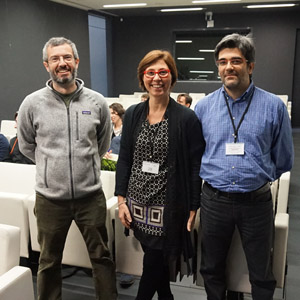Thursday, 21 January 2016
Dr. Maurizia Palummo discusses novel semiconducting 2D materials for opto-electronics
Dr. Maurizia Palummo offered, on January 21, an ICN2 seminar about Transition metal dichalcogenides. She presented recent results obtained by her team and elucidated the time scale and microscopic origin of light emission in these two-dimensional systems. The speaker was invited by the ICN2 Theory and Simulation Group, led by Dr. Pablo Ordejón.

In the last years, two-dimensional (2D) transition metal dichalcogenides (e.g., MX2, with M=W,Mo and X=S,Se) are being intensely investigated for application in solar cells and light-emitting devices. During an ICN2 Seminar held on January 21, Dr. Maurizia Palummo, from the Department of Physics at the University of Rome "Tor Vergata" (Italy) and the European Theoretical Spectroscopy Facility (ETSF), offered a review of the present knowledge on their electronic and optical properties. After being introduced by Riccardo Rurali, from ICMAB-CSIC, the speaker showed the importance of many-body interactions to interpret them.
Dr. Maurizia Palummo discussed the work she led based on ab-initio DFT, GW and BSE simulations, which has shown the extraordinary sunlight absorption of these monolayers and their unique potential to develop nm-thick solar cells with unprecedented power density and broadband sunlight absorption. She also presented recent first-principles excited state calculations regarding the intrinsic exciton radiative lifetimes of TMDs. The results obtained by her team elucidate the time scale and microscopic origin of light emission in these two-dimensional systems. The wide radiative lifetime tunability, together with the ability shown here to predict radiative lifetimes from computations, hold unique potential to manipulate excitons in TMDs and their heterostructures for application in opto-electronics and solar energy conversion.

